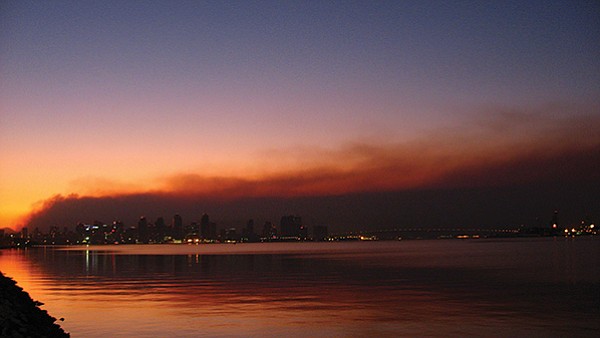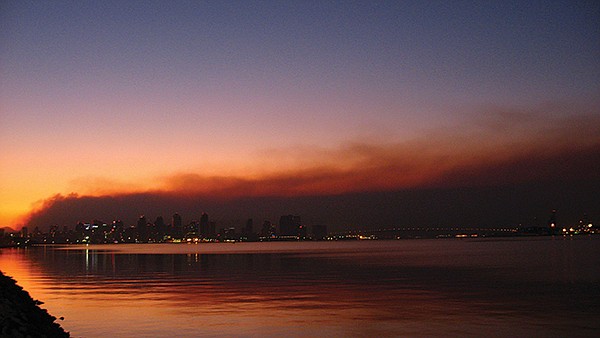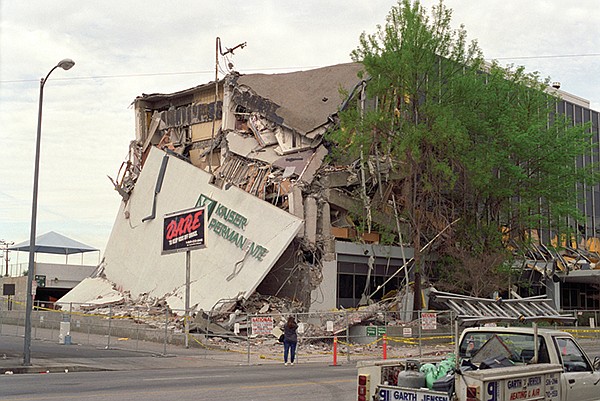 Facebook
Facebook
 X
X
 Instagram
Instagram
 TikTok
TikTok
 Youtube
Youtube

Can San Diego and other West Coast metro areas make money because of the hurricane-prone eastern U.S. and the Caribbean? Florida and Caribbean islands are tourist havens. Now some of those areas lie in ruins as a result of Hurricane Irma and Hurricane Maria. Hurricane Harvey clobbered Houston, and earlier, Katrina crippled New Orleans and Sandy bashed the East Coast from Florida to Maine.

If what’s called “global warming” or the less apocalyptic “climate change” is real and a cause of such calamaties, can we expect that in the short or long run the West Coast will be stealing visitors, and perhaps house hunters, from the East?
The answer is it’s possible but not in great numbers, and only in the short run. But let’s look first at the science involved.
(Embedded in the definitions of “global warming” and “climate change” are assumptions that increased levels of carbon dioxide and other pollutants are causes of the increasingly warm earth, and that humans are greatly responsible. Global warming deniers concede that the earth has gotten warmer in the past 30 years, but, they say, the earth has gone through many periods of warming and cooling. Generally, deniers doubt human activity is to blame. This column is aimed at both believers and deniers.)

It is true that the West Coast almost never gets hit by hurricanes. As Scientific American explains, “Hurricanes in the northern hemisphere form at tropical and subtropical latitudes and then tend to move toward the west-northwest.” On the East Coast, they head toward land. On the West Coast, they tend to head farther out to sea. Also, along the East Coast, the Gulf Stream can push water temperatures above 80 degrees Fahrenheit, and hurricanes are fueled by the heat energy stored in warm ocean water. By contrast, “Along the West Coast, [water] temperatures rarely rise above the lower 70s Fahrenheit.” But it is true that “occasionally, tropical storms do strike coastal southern California. By the time they do, they have lost their hurricane-force winds, although they may still bring with them very heavy rainfall that can cause extensive flooding.”
So, hurricane-spooked folks might head for San Diego, Los Angeles, or the Bay Area. Hold on. “We have earthquakes and fires,” says Kelly Cunningham, economist at National University. Wildfires are certainly exacerbated by a warmer earth, and earthquakes may be affected, too, along with tsunamis and volcanos.
The Union of Concerned Scientists believes that global warming is increasing wildfire risks. “As the climate warms, moisture and precipitation levels are changing, with wet areas becoming wetter and dry areas becoming drier,” writes the union. “Higher spring and summer temperatures and earlier spring snow-melt typically cause soils to be drier for longer, increasing the likelihood of drought and a longer wildfire season, particularly in the western United States. These hot, dry conditions also increase the likelihood that, once wildfires are started by lightning strikes or human error, they will be more intense and long-burning.”
The National Wildlife Federation says that with a warmer earth, “More fuel for forest fires will become available because warmer and drier conditions are conducive to widespread beetle and other insect infestations, resulting in broad ranges of dead and highly combustible trees.” Also, lightning may increase. “In the western United States an increase of 1.8 degrees Fahrenheit in temperature is expected to lead to a six-percent increase in lightning.”
And a warmer earth could intensify earthquakes, too, some scientists are saying.
A recent Australian-led study indicates that climate-related activities may affect the moving of tectonic plates — an extremely slow process. A team of researchers concluded that “the strengthening Indian monsoon had accelerated movement of the Indian plate over the past 10 million years by a factor of about 20 percent,” according to alternet.org. That’s an awfully long time.
But Patrick Wu, a geologist at the University of Alberta in Canada, says that melting ice can be a problem in the shorter term. The weight of polar ice “sort of suppresses the earthquakes, but when you melt the ice the earthquakes get triggered,” Wu told thoughtco.com. Melting ice may also set off tsunamis and volcanos, say some scientists.
So, can San Diego and other West Coast destinations cash in on East Coast hurricanes? The hurricane season runs from June 1 to November 30. The big traffic of northerners seeking sunshine runs from November through February, so only November traffic would be hit by hurricane fears, points out Encinitas-based hotel guru Jerry Morrison.
However, “there is an opportunity [for the West Coast] to capture some of that business” from Florida and the Caribbean, says Morrison. But we have to be smart. “If we really invest in marketing and get airlines to give special pricing — yes, we could do it,” he says. “If we had an aggressive campaign, promote the West Coast, try to get the airlines to give us more capacity and give people a break on the fares,” the West Coast could be successful. But it’s “highly unlikely” that the airlines would cooperate. And the chances of a big promotion campaign are “pretty slim. We should be running big ads in the New York Times saying, ‘Come and enjoy our beaches in Santa Monica and San Diego — Special: four nights with free parking, free internet.’ That’s what we should be doing, but I am not holding my breath.”
Robert Rauch, chief executive of RAR Hospitality, a San Diego–based hotel management and consulting firm, says, “We might pick up something in the short term. We have in the past,” such as when a convention center has had to close down because of a calamity. People aren’t likely to change long-term traveling habits because of one disaster, particularly since the West has its own bugaboos.”
Will storm-battered people move to the West Coast from the East? National University’s Cunningham points to housing prices. According to Zillow.com, the median home value in San Diego is $583,300, San Jose $892,400, Los Angeles $632,000, and San Francisco $1.2 million. And Florida? Miami $300,800, Tampa $185,700, and Orlando $169,700. ’Nuf said. For every home buyer coming into California, there are three moving out, says CoreLogic. San Diego’s population is still growing “because of international immigration and babies, but domestic migration is negative,” says National University’s Cunningham.


Can San Diego and other West Coast metro areas make money because of the hurricane-prone eastern U.S. and the Caribbean? Florida and Caribbean islands are tourist havens. Now some of those areas lie in ruins as a result of Hurricane Irma and Hurricane Maria. Hurricane Harvey clobbered Houston, and earlier, Katrina crippled New Orleans and Sandy bashed the East Coast from Florida to Maine.

If what’s called “global warming” or the less apocalyptic “climate change” is real and a cause of such calamaties, can we expect that in the short or long run the West Coast will be stealing visitors, and perhaps house hunters, from the East?
The answer is it’s possible but not in great numbers, and only in the short run. But let’s look first at the science involved.
(Embedded in the definitions of “global warming” and “climate change” are assumptions that increased levels of carbon dioxide and other pollutants are causes of the increasingly warm earth, and that humans are greatly responsible. Global warming deniers concede that the earth has gotten warmer in the past 30 years, but, they say, the earth has gone through many periods of warming and cooling. Generally, deniers doubt human activity is to blame. This column is aimed at both believers and deniers.)

It is true that the West Coast almost never gets hit by hurricanes. As Scientific American explains, “Hurricanes in the northern hemisphere form at tropical and subtropical latitudes and then tend to move toward the west-northwest.” On the East Coast, they head toward land. On the West Coast, they tend to head farther out to sea. Also, along the East Coast, the Gulf Stream can push water temperatures above 80 degrees Fahrenheit, and hurricanes are fueled by the heat energy stored in warm ocean water. By contrast, “Along the West Coast, [water] temperatures rarely rise above the lower 70s Fahrenheit.” But it is true that “occasionally, tropical storms do strike coastal southern California. By the time they do, they have lost their hurricane-force winds, although they may still bring with them very heavy rainfall that can cause extensive flooding.”
So, hurricane-spooked folks might head for San Diego, Los Angeles, or the Bay Area. Hold on. “We have earthquakes and fires,” says Kelly Cunningham, economist at National University. Wildfires are certainly exacerbated by a warmer earth, and earthquakes may be affected, too, along with tsunamis and volcanos.
The Union of Concerned Scientists believes that global warming is increasing wildfire risks. “As the climate warms, moisture and precipitation levels are changing, with wet areas becoming wetter and dry areas becoming drier,” writes the union. “Higher spring and summer temperatures and earlier spring snow-melt typically cause soils to be drier for longer, increasing the likelihood of drought and a longer wildfire season, particularly in the western United States. These hot, dry conditions also increase the likelihood that, once wildfires are started by lightning strikes or human error, they will be more intense and long-burning.”
The National Wildlife Federation says that with a warmer earth, “More fuel for forest fires will become available because warmer and drier conditions are conducive to widespread beetle and other insect infestations, resulting in broad ranges of dead and highly combustible trees.” Also, lightning may increase. “In the western United States an increase of 1.8 degrees Fahrenheit in temperature is expected to lead to a six-percent increase in lightning.”
And a warmer earth could intensify earthquakes, too, some scientists are saying.
A recent Australian-led study indicates that climate-related activities may affect the moving of tectonic plates — an extremely slow process. A team of researchers concluded that “the strengthening Indian monsoon had accelerated movement of the Indian plate over the past 10 million years by a factor of about 20 percent,” according to alternet.org. That’s an awfully long time.
But Patrick Wu, a geologist at the University of Alberta in Canada, says that melting ice can be a problem in the shorter term. The weight of polar ice “sort of suppresses the earthquakes, but when you melt the ice the earthquakes get triggered,” Wu told thoughtco.com. Melting ice may also set off tsunamis and volcanos, say some scientists.
So, can San Diego and other West Coast destinations cash in on East Coast hurricanes? The hurricane season runs from June 1 to November 30. The big traffic of northerners seeking sunshine runs from November through February, so only November traffic would be hit by hurricane fears, points out Encinitas-based hotel guru Jerry Morrison.
However, “there is an opportunity [for the West Coast] to capture some of that business” from Florida and the Caribbean, says Morrison. But we have to be smart. “If we really invest in marketing and get airlines to give special pricing — yes, we could do it,” he says. “If we had an aggressive campaign, promote the West Coast, try to get the airlines to give us more capacity and give people a break on the fares,” the West Coast could be successful. But it’s “highly unlikely” that the airlines would cooperate. And the chances of a big promotion campaign are “pretty slim. We should be running big ads in the New York Times saying, ‘Come and enjoy our beaches in Santa Monica and San Diego — Special: four nights with free parking, free internet.’ That’s what we should be doing, but I am not holding my breath.”
Robert Rauch, chief executive of RAR Hospitality, a San Diego–based hotel management and consulting firm, says, “We might pick up something in the short term. We have in the past,” such as when a convention center has had to close down because of a calamity. People aren’t likely to change long-term traveling habits because of one disaster, particularly since the West has its own bugaboos.”
Will storm-battered people move to the West Coast from the East? National University’s Cunningham points to housing prices. According to Zillow.com, the median home value in San Diego is $583,300, San Jose $892,400, Los Angeles $632,000, and San Francisco $1.2 million. And Florida? Miami $300,800, Tampa $185,700, and Orlando $169,700. ’Nuf said. For every home buyer coming into California, there are three moving out, says CoreLogic. San Diego’s population is still growing “because of international immigration and babies, but domestic migration is negative,” says National University’s Cunningham.
Comments